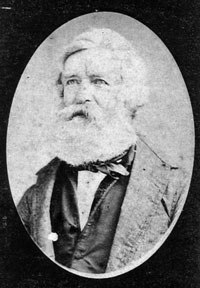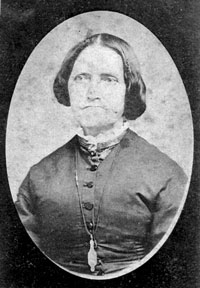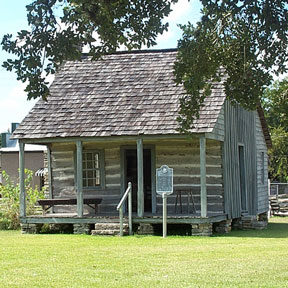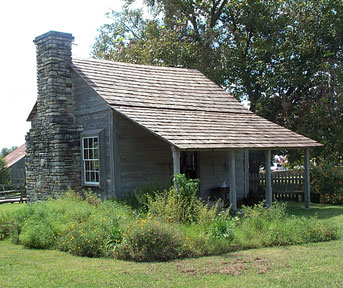Biegel, Texas
In the spring of 1831, Friedrich Ernst settled on the banks of Mill Creek, in Austin County. He was so enchanted with the land, that he wrote a glowing letter to a friend in his homeland, Germany. The letter was published in a newspaper. Joseph Biegel read the letter and decided that this was the place for his family to start a new life. Upon arriving in Mexican Texas, Biegel was issued a league of land (4,400 acres) by the Mexican Government. Biegel, 29, and Margarethe, his wife, 34, began attempting to tame their new home. Indians were a major threat and Biegel kept his weapon nearby as he plowed his fields. Indian raids caused the Biegel's along with their neighbors to move down the Colorado River for several months.
Upon returning the Biegel's were soon forced to head east as the wall of serpents and eagles of Santa Anna's army was sweeping across Texas during the Revolution. After San Jacinto, the Biegel's returned to their farm and once again began to develop the area. In order to entice neighbors to the area; Biegel sold various parts of his league to fellow immigrants. By the 1850's a small community had emerged, with the Biegel homestead being the center of activity. It was reported that there was around 50 houses, a gristmill, cotton gin, saw mill and a post office. The census of 1850 listed Biegel as owning 411 improved acres, 300 unimproved acres with a total value of $800. He also owned 9 horses, 1 mule, 40 milk cows, 7 oxen, 25 swine, and 40 head of cattle with a total value of $1100. The records also show the presence of cotton, beans, potatoes, butter, and honey. Biegel also had a slave couple with four children.
Joseph Biegel's wife, Margarethe, died in 1866. Two years later, Biegel married Margarethe's 27-year-old niece, Catharine Winesdörfer. Joseph Biegel died at the age of 73 in 1875. Catherine lived until 1883. All were buried in the Biegel family plot.
The Biegel Settlement (the area was never incorporated) boasted a blend of nationalities. Emigrants from France, Prussia, Poland, Denmark, Austria and Switzerland resided here.
Two early residents of Biegel are worth mentioning, R. E .B. Baylor and Asa Hill.
Baylor settled there in the early 1840s. Baylor, a Baptist minister, was elected to the Supreme Court of the Republic of Texas, and was a Fayette County delegate to the annexation conventions of 1845. When Texas joined the Union, Baylor helped draft the first state constitution, championing the causes of free public schools, homestead exemptions and the exclusion of clergy from the legislature. He was a state judge for 18 years. He traveled his district by horseback, conducting court by day and preaching in the towns in the evening. In 1845, Baylor provided influence to start the college that now bears his name, Baylor University.
Asa Hill, a veteran of the Texas Revolution, moved to Biegel in 1839. During the Mexican Invasion of 1842, Hill and two of his sons, joined the Texian Army expedition that is known as the Mier Expedition.
February 23, 1861 saw Texas and Fayette County voting on whether to secede from the Union. Fayette County voted not to secede by a 626 to 580 count. Texas seceded despite Fayette and several other counties with similar votes.
On January 4, 1863, a secret meeting was held in the Biegel Settlement and a letter was sent to the ranking Confederate officer in La Grange, Brigadier General William G. Webb, formerly a local lawyer. The letter outlined the resident's reasons for protesting the draft. The major objection was the increase in the poverty level for the farmer's families, should they have to leave the farms. Five men stating that they represented about 120 citizens signed the letter. This was a very bold and potentially dangerous statement in a time of war.
The Confederacy reacted by declaring a state of martial law in Fayette County. The Governor of Texas, Francis Lubbock, immediately traveled to La Grange and met with the dissidents. The Governor gave a very plain, positive talk to them and extracted a promise of enlistment from a majority of the protesters. Lubbock's persuasive speech and the artillery piece belonging to the Confederate Cavalry Brigade that backed him up quieted things down. Several Biegel residents heroically served the Confederacy.
During Reconstruction, things were pretty tough as the members of the Biegel Settlement were trying to survive the economic and political disaster. The former slaves, who had become sharecroppers, struggled along with their former owners against the failed economy. Relations between the two appeared to be cordial as they all banded together during harvest time and helped one another.
In the late 1800s, the railroad came to nearby Fayetteville on its way to La Grange from Houston. The tracks missed the settlement causing the decline of the area in population as people moved to be near the railroad. Biegel had become a peaceful agricultural community. There was now a school and Verein hall. The hall was a focal point for the annual Schützen Verein or shooting club festival. Yearly, the community gathered for a day of socializing, food, drink, dancing and a target shoot of which the winner was declared the König Schützen or King of the Shooters for the upcoming year.
Life was quiet in the Biegel area during the 20th century as crops and children were raised. Some of the children went off to fight in the World Wars and didn't return, others went to the big city to find a job, and a very hardy few kept the farming tradition alive.
In the early 1970s, the Lower Colorado River Authority (LCRA) chose 6000 acres in the Biegel area as the site for a new electric generation facility. When LCRA acquired the area, some of the original log cabins were moved from the area to be preserved. They now can be seen in Henkel Square in Round Top and at the San Antonio Botanical Gardens. At least six cemeteries were moved to make way for the construction of the Fayette Power Project (FPP). The Biegel Family Cemetery was one of them. A total of 150 remains were relocated, some to the city cemetery in La Grange (Asa & Green Washington Hill) and some to new cemeteries still on plant property. Today much of the area of Biegel Settlement is under the waters of the FPP lake.






